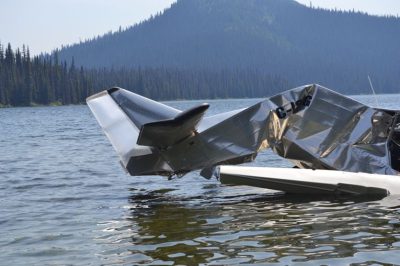
The Transportation Safety Board (TSB) released a report this week (Oct. 3) on their investigation into the June 25, 2023 crash of an ICP Savannah amphibious floatplane into Simpson Lake, about 77 nm southwest of Fort St. John, British Columbia. The accident claimed the life of its pilot/owner, the only person on board.
After the aircraft was reported overdue, it was located on the lake surface, upright, and with the aft section of the fuselage collapsed downward. A 10-pound sack of crushed gravel was found in the aft section, leading the investigators to conclude that the aircraft experienced a hard landing.
The Savannah is an Italian-manufactured, high-wing, single-engine aluminum aircraft with two-place side-by-side seating. It is available either in kit form or as a factory-built airplane, eligible for registration in Canada as an Advanced Ultralight Aeroplane (AULA). The occurrence aircraft was registered as an AULA. The Savannah is similar to a Zenith CH 701; the 701’s designer Chris Heintz considered the Savannah to be a copy of his design.
The TSB investigators discovered unauthorized modifications to the aircraft, one of which consisted of an engine conversion of the 80-hp Rotax 912F normally aspirated engine to a turbocharged version that produced 115 hp. The kit is known as the ‘914-kit’ due to its matching of a turbocharged Rotax 914’s horsepower. The kit added nine lbs to the engine weight. However, the engine conversion kit was not approved by the manufacturer.
The aircraft also had a modification that added vortex generators (VGs) to the wing. Although the kit used for this modification was one provided by the manufacturer, it was not installed as per the manufacturer’s instructions.
According to the investigation report, there were other factors that may have contributed to the crash, such as adverse weather and a fuel return line that contained an electrical grommet, blocking passage of the returning fuel and possibly causing the engine to run rough.
However, the TSB report focussed on regulations, procedures and responsibilities surrounding modifications of AULA. One such responsibility is the requirement of an owner to obtain the manufacturer’s approval before making any modifications to their aircraft.
Furthermore, the TSB points out, when an AULA is sold, both the current owner and the new owner are to sign a ‘Fit For Flight Form’ which is required by Transport Canada in order to re-register an AULA. This form contains a declaration that the aircraft “…is fit for flight, there are no unapproved modifications […], all mandatory actions have been completed and that there are no outstanding maintenance actions.” The TSB investigators discovered that TC had the form on file, but with no names, dates or signatures of either the previous or the new owner.
